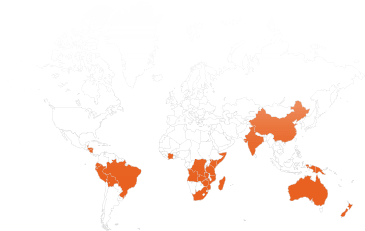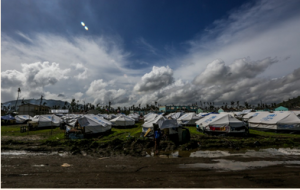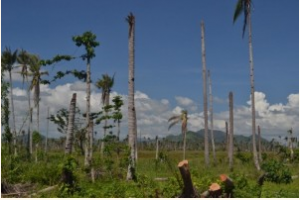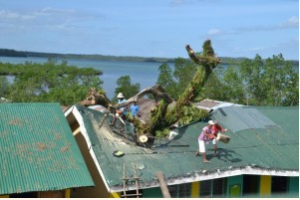Even though Typhoon Haiyan caused a lot of damage, people in Leyte province, Philippines, are doing their best to keep moving forward and rebuild their lives. Communication with our partners and volunteers on the ground has allowed us to paint a picture of the updated situation after what happened after Typhoon Haiyan. And we are pleased to present these positive comments from them.
What Happened to the Philippines After Typhoon Haiyan?
“For outsiders; the recovery might seem relatively simple; rebuild the homes and restore the lives of those families and return back to normality. Unfortunately, the recovery efforts, especially for the coastline communities are not as simple. The first complication arises as a result of the sheer devastation inflicted to the local landscape; it’s not only homes and possessions that have been destroyed, but also the vast majority of the local livelihood. Aside from that, most families cannot rebuild on the original site of their previous homes since they did not previously own the land or because the site of their previous home lie within 50 meters of the shoreline – an area which has been strictly blacklisted for building upon.
Rebuilding Tacloban After Typhoon Haiyan

That said, rebuilding at the present moment in time is completely out of the question; since families have not been allocated any land to start construction on. Instead, options being explored are looking into livelihood development as an immediate means to assist the families of children enrolled on its Child Sponsorship Program. Several options are still being discussed and evaluated, but as of right now a micro-lending program to construct and distribute fishing boats seems to be trumping other options. The advantages of this set-up will reduce the sentiment of dependency for many families by giving them the opportunity to once again create their own livelihood and build their own future. Restoring basic services such as fishing will also help stimulate the local economy, drive down the local cost of fish and as a result benefit the extended community of the area as a whole.
The earlier months of this year brought much rain, which created all manner of barriers to rebuilding. Flooding meant big muddy areas everywhere; hardly a dry place to sleep and unfortunately this also came with a lot of diseases. A lot of medical volunteers are working very hard to help as much as they can. The line-up in front of the pharmacy is very long, every day, but we are glad there are medical supplies coming in and people are slowly getting help.
In terms of housing, different areas were affected in different ways. Some still live in the disaster tents they got supplied, some have rebuilt a house from scrap metal and some are still living in the buildings used for shelter housing.
The debris that buried most houses and possessions is beginning to reduce. People clear their area out and make a big pile of rubbish on the site of the road for the trucks to pick up. Every day we see those trucks collecting garbage. Although there is still a lot of rubbish around, progress is noticeable. Even as progress in the power lines and running water is noticeable but very slow. More and more places have running water, some through water points in a central area and others through the tap in their house.
Downtown Tacloban is getting electricity block by block; a very positive progress in that more shops and restaurants are opening in Tacloban City by the week. This means that businesses are starting to get back on their feet and people can earn incomes so they can take care of themselves, their family and their house.
Even nature is slowly making its way back to normal. The mountains in the distance are getting back their luscious texture and beautiful green colour again and rural villages have started to plant new rice fields. However, most of the coconut trees were snapped whole and as a result there are hardly any coconuts left. This is bad for the coconut farmers because they live on the income from their coconuts – juice and coconut wine, known locally as tuba.
Volunteer work is proving to be continually effective. Building projects are working continuously at the moment and volunteers who are working together with local builders are working on building houses. Everything needs to be done by hand and are making very good progress. The nutrition project has been running as well with great success over the past few months following the typhoon. Nutrition volunteers cook food for the kids and do a health check-up on the kids, by weighing them and checking their height.
Social worker volunteers have also been having talks with the mothers in different villages about how to take care of their kids that have been traumatised by the typhoon. Additionally, the team are working together with other local organisations to help people clear out their house from all the dirt, rubbish and damage the storm brought with it. The mothers club is also up and running and sewing machines have been donated so the mothers can start making schoolbags and other things, with which they can sell to earn money.
Apart from the projects, the volunteers are giving a helping a hand where needed and starting some of their own projects over the past few months. For instance, removing a tree out of a school classroom. A group of seven volunteers packed their bags for an overnight trip to a lovely village on a little island just north of Leyte. During the typhoon, most of the school got spared from damage except for one classroom. A massive tree got blown over by the strong winds and fell straight down onto the roof of the room. New supplies were bought to rebuild the classroom but first the tree had to be moved. Together with the volunteers, the locals started to cut down the tree piece by piece, whilst others helped by cleaning up and keeping the local children at a distance.
A lot of the village boys came to help and seemed very happy to make themselves useful. Like the principal said, “they need fresh motivation from volunteers like you to keep us going.” So together with the local people, by the end of the day the tree had been cut down!
With a whole group of people everything was cleaned up and the classroom was ready for a new roof. The village has two very good carpenters who are ready to rebuild the school with the materials supplied by volunteers for them. The classroom is now already in use by grade IV students and they are very happy with it!”
The Philippines Now After Typhoon Haiyan
We’d like to say a big thank you to all the volunteers that have helped out in this effort and all the volunteers that are ready to go out to Tacloban. The work is slow but effective and by working with the local community leaders, we can help to deliver what they need to get things back on track.




Recent comments